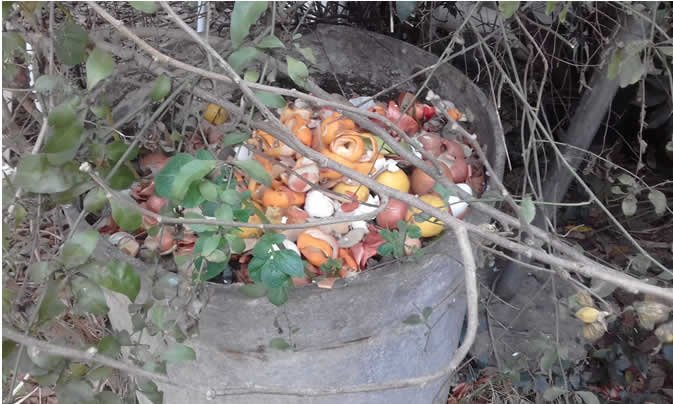I started a zero waste journey some years back. I'm not there yet, but getting closer. In these posts I plan to show what worked and didn't worked for me, in the hope that it might be useful for someone.
Why it's important to head toward a zero waste life is evident. But one things is to know it and another to Know it. My pivoting moment was when I saw two documentaries: one about the huge plastic island in the Pacific and a second one about the recycling of flip flops leading to a business. Together they told me the problem was serious, and there was opportunity waiting in the process of finding a solution.
Looking at my trash bag I realized that about 70% of the contents were vegetable peels and food leftovers. So there I put the effort first.
For the vegetable peels I started a compost bin made out of an old cement water tank located under a tree.
What I've learned about composting in the city
Composting is the process of letting food left-overs be in a humid environment and let bacteria and fungus to decompose it.
What can be composted?
Anything that was once alive can be composted, but for my settings I only compost directly vegetables and eggshells. Fruit peels I pass through my living compacting machine, i.e. the rabbit. And cooked food scraps are taken cared of by the dog.
Could all of that be put in a compost pile? Yes, but for meat I would need a meter cubic composting system, which is too complicated and takes work. I am all about saving the environment, but I don't have the muscle or the space for a hot compost pile.

What does the rabbit eat?
As rule of the thumb I give the rabbit vegetables and fruits we eat raw and avoid nightshades and strong herbs. Example: carrots peels go to the rabbit, potato peels go to the compost bin.
The rabbit manure goes right to the garden in settings I will not touch till a couple of months later, or to the garden compost pile. The garden compost pile is essentially a pile with garden clippings. I have several of these around, one per main area.
The rabbit eats only my vegetable left overs plus the garden left overs and grass clippings. He doesn't eat any "store-bought" food, and takes all the water from the food he eats. Meaning: there's not water in the cage. And no. It's not out of cruelty, nor it's impossible as I've been told by a supposed expert. The little guy has been eating like this for about three years, and he is happy, strong and active. When we take him out of the cage he runs and plays, and he doesn't seem desperate to attack my plants either. I wouldn't let him unsupervised though.
I'm not sure any vegetable combination would work. So here is what I do. I replace my own dinner by a juice promoted by Don Tollman called CABALA. This juice is a fasting juice. It has:
Carrots
green Apple
Beetroot
red Apple
Lemon with peel
yellow Apple
More about this juice: https://tolmanselfcare.com/blogs/blog/the-healing-powers-of-cabala
These peels go to the rabbit every night. I still give him grass and banana leaves a couple of times a day, but the juice left overs take him happily on their own.
Dog "approved" food
Dogs are particular, and as personal as their families. My dog's preferences taught me a lot about balanced formulation of a plate. So I cook for us, but for him as well.
He would eat anything with animal fat and protein, all cooked, except for wheat. So rice as a carb is more dog friendly than spaghetti for example. He eats cooked vegetables as long as they have, again, protein or fat.
So a typical meal that is for us, but also dog friendly would be rice with home-made bolognesa sauce with tons of veggies in it cut very small. I use only Himalayan salt or sea salt and olive oil to cook. This is very easy to do in about 30 minutes, it can be frozen, it holds well for the next day in the fridge, and my dog raves about it.
Worms compost
I have a small area where I promote worm composting. I say promote because it's not a box with the lil guys in it. It's just one planter under the banana trees where I place small left overs that can be turned into dirt in under three months. The left overs I use for the worms are the juicer pulp, coffee grinds and yerba mate. This dirt is the one I use to start seedlings.
Conclusions
Most of my waste was food left overs. The way I re-purposed it, can be put in four categories:
- cooked left overs - the dog
- fruits and vegetable we can eat raw - the rabbit
- spoiled fruits and vegetables, eggshells and veggies we eat cooked - the compost tank
- grinds and juicer pulp - the worm compost
I hope any of this gives you ideas to reduce your waste in a way that works for you.
Next story: Zero waste journey part 1.5. In this post I show part of my garden, which was possible because of composting.
Do you compost? I want to hear all about it.
✅ @elearah, I gave you an upvote on your post! Please give me a follow and I will give you a follow in return and possible future votes!
Thank you in advance!
Thanks for the upvote! Following you now.